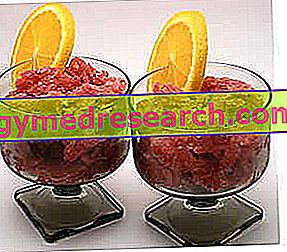What is granita
Granita is a frozen compound of water, sugar and fruit juices or infusions that is obtained by slowly crystallizing the water contained in the mixture.

Granitas are distinguished from ice creams and sorbets by a series of structural aspects:
- Absence of creaminess and softness
- Grainy and crystalline appearance
- Semi-dense (or semi-liquid) consistency
- Minimum overrun ("overrun" means the ability of the mixture to incorporate air during the freezing phase): in granita, the incorporation of air must be very low
- Static and slow freezing
Production
The preparation of granita is decidedly simpler than that of an ice cream: it requires less attention, less time for formulation and the cost is much lower.
The most important steps for the production of granita can be summarized in a few simple steps:
- Mixture formulation
- Freezing and scraping
- Sale (in the case of artisan granitas) or immediate consumption
Mixture formulation
In the formulation of a traditional granita only a few simple ingredients appear, namely water, sugar and juices (or infusions).
The percentage of sugar contained in a granita is commonly between 20 and 24%, although it is not uncommon to find slush with 17% of sugars. In general, the percentage of sugars varies depending on the type of fruit used.
The most used sugar in the preparation of granite is the common sucrose. However, the use of any added secondary sugars (dextrose, invert sugar, honey, glucose syrup, etc.) is not recommended, as it happens in the formulation of an ice cream. These sugars, in fact, lowering the freezing point of the water contained in the mixture, would limit the formation of ice crystals required instead in the granita.
- In the production of granita different conditions are therefore sought - almost contrasting - with respect to those desired for ice cream: if on the one hand we find in fact the granularity and the ice crystals of the granita, on the other hand we find instead the creaminess and the softness of the ice cream .
Normally, the base of a granita is a syrup made with 60% sugar and water. This means that to prepare 1 L of syrup for granita, 600 g of sugar on 400 ml of water must be dissolved.
Curiosity
Until a few years ago, the density of syrups for granite was measured using a particular instrument called a densimeter (or more simply a syrup scale), and was expressed in degrees Bé (Baumé degrees). The degrees Bé indicate the quantity of sugar contained in a syrup at a temperature of 20 ° C.
With the improvement of the ice-cream art, the densimeter was no longer able to provide precise data due to the presence of other components in the mixture, such as secondary sugars and thickeners. Thus, the densimeter was replaced by a more precise instrument, the refractometer . The new instrument is based on the measurement of the refractive index of light and is able to instantly signal the sugar content in a solution. In other words, the refractometer is able to evaluate the quantity of solid substances dissolved in a liquid. The value obtained is expressed in degrees Brix (° Bx):
1 ° Bx = 1 part of dry matter in 100 parts of solution
In granite, the sugars in solution should oscillate between 17 and 21 ° Brix: this means that a solution should contain a quantity of sugar equal to 17-21%.
To this basic syrup, fruit juices (or pulp) or tea or coffee infusions are then added. Subsequently, we pass to the chilling phase, skipping the passage of the maturation of the mixture (typical instead of ice cream).
Freezing and scraping
After the formulation and preparation of the mixture, it immediately proceeds to freeze, which must be static or discontinuous to avoid incorporating air into the compound. In other words, during the freezing phase, the granita must not be continuously whipped (as it happens for ice cream) in order to prevent the air from being incorporated into the mixture. An eventual incorporation of air would produce an excessively dry granita: the product must instead appear damp and soft, just like the snow in phase of dissolution.
During freezing, the product should occasionally be scraped off with a spatula where it crystallizes: this operation has the purpose of favoring the formation of new ice crystals. We proceed in this way until we obtain the desired consistency.
At the industrial / artisanal level, some machines called "vertical freezers" are available, which allow slow freezing of the mixture. Occasionally, during the freezing of the mass, a special mechanical arm connected to the machine must be operated, able to scrape the crystallized product from the walls.
At home, it is sufficient to use the freezer (not the ice cream maker) and occasionally "scrape" the ice mass from the container walls.
Granita is therefore ready to be displayed in shop windows (at the artisan level) or to be served and tasted (at home).
Prepare the granita at home
To make a lemon granita with 20% sugar, proceed in this way.
- Prepare the base syrup by dissolving 250 g of sugar on 500 ml of water. Bring the mixture to the boil, then let it cool completely.
- Pour the chilled syrup into a plastic container: we do not recommend the use of copper or aluminum containers because these metals could alter the taste of the fruit. Combine 500 ml of lemon juice and mix.
- Place the container in the freezer at temperatures between -15 and -16 ° C.
- Remove the tray after a couple of hours: minute ice crystals will have formed. Scrape the crystallized part to facilitate the development of new microcrystals, then place again in the freezer.
- Continue in this way until the desired consistency and graininess is obtained. The freezing time varies from 5 to 8 hours, and is mainly influenced by the size of the tray.
At the end of the operation, a crystalline and soft mass will be obtained at the same time: the granita can therefore be served immediately in glasses or in cups.
Now let's see some examples of video recipes to make granita at home.
Almond Granita
Almond Blend in My Way
X Problems with video playback? Reload from YouTube Go to Video Page Go to Video Recipes Section Watch the video on youtube



